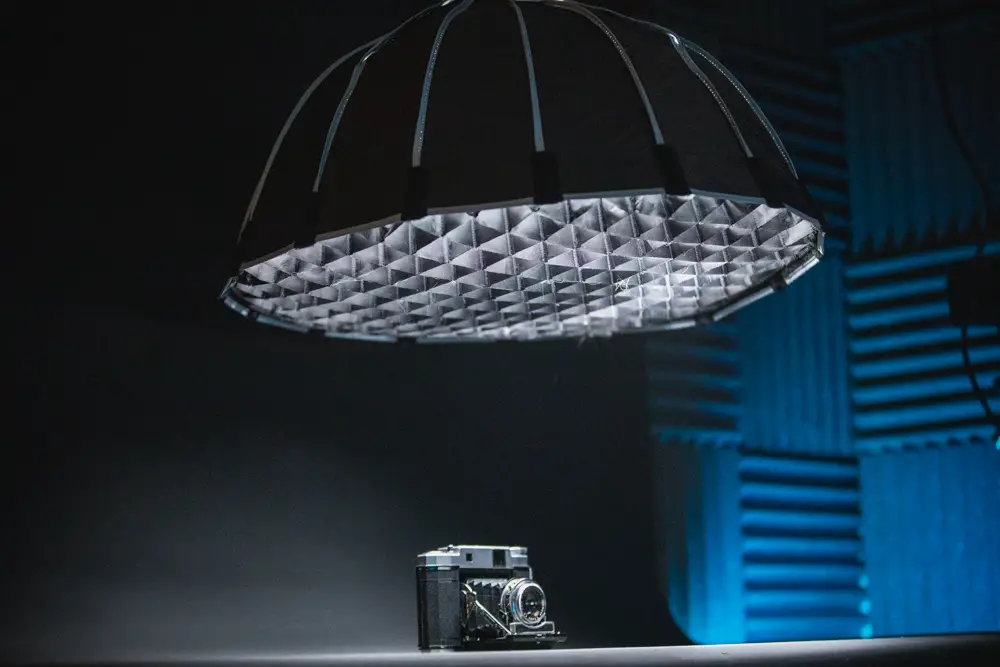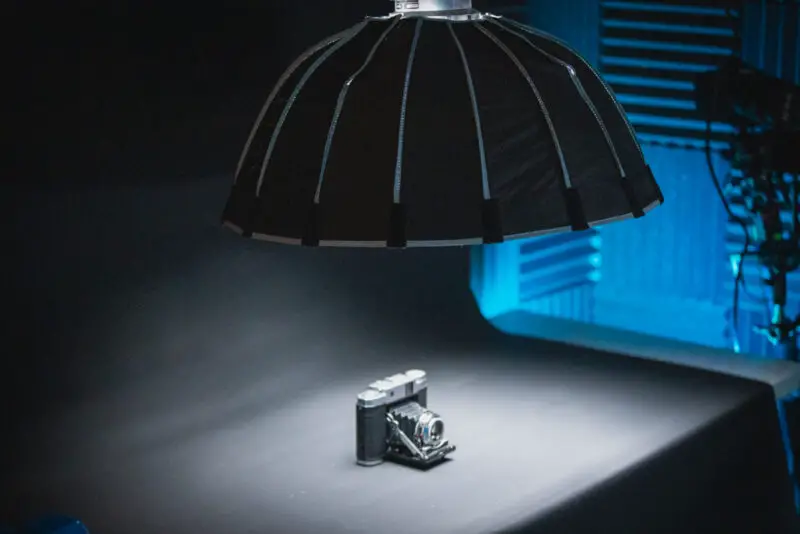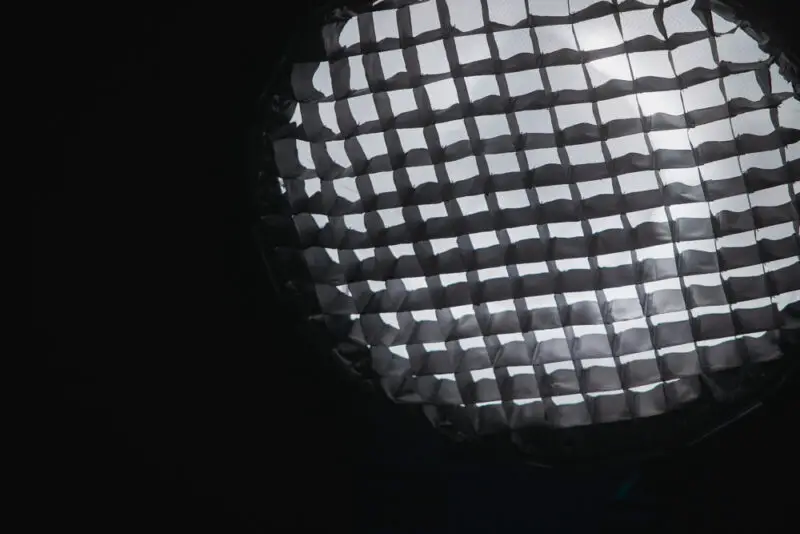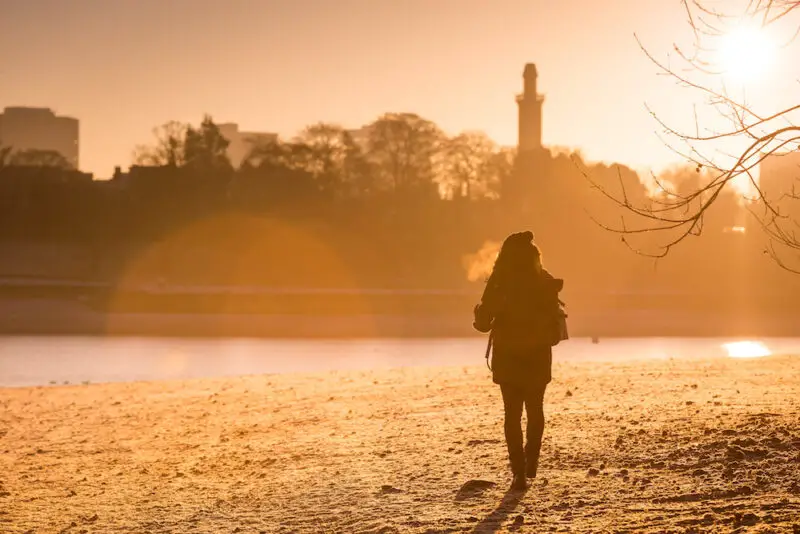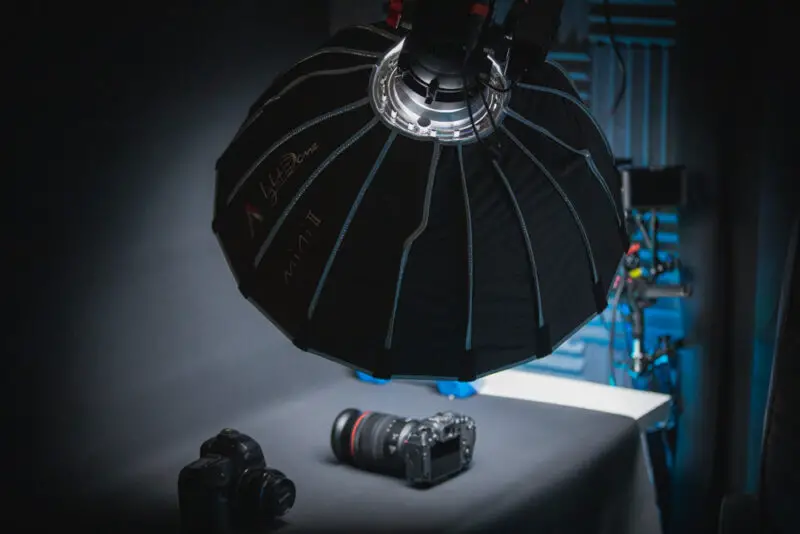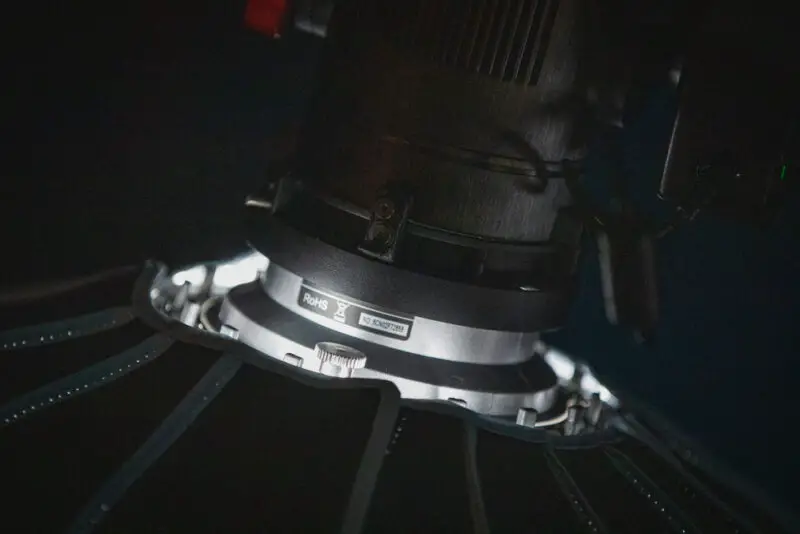What is a softbox? In a literal description, a softbox might be thought of as a “soft box” or something that changes light. This may not be an accurate description, but it does give us some clues as to what kind of lighting it may provide.
A softbox is nothing more than an accessory to soften the light of a flash or continuous light placed in it, to make the light more diffuse (as the name implies) and more directional.
- Appearance
- Uses and effects
- Things to keep in mind
- The main uses
- Softboxes vs. sunshades
- Why choose a softbox?
- Any disadvantages?
- Why use softboxes?
- Is there a best size?
- An ideal shape
How is this diffusion achieved? Simply put, a flash or light source placed in a softbox must allow light to pass through one or more translucent layers that are part of the softbox, making the scene look more diffused and natural. The large surface area of the illuminated scene also plays a crucial role in this softness.
Multiple things can influence the direction of light including the shape, structure, translucent side, and opaque surround. It typically has a silver interior that reflects the light and directs it toward the translucent side. This way, the light emits exactly in the direction indicated by the line connecting the light source to the translucent side of the softbox.
Find more information about softbox diffusion
The softness of the light from the softbox depends on several factors.
- The number of translucent layers the light must pass through before it reaches the subject. Some softboxes have an intermediate translucent layer before the outer layer, which tries to distribute the light more.
- The size of the softbox and its proximity to the subject. The larger the softbox and the closer it is to the subject, the stronger the light will be and the more natural the effect will be.
Another useful article: What Is a Viewfinder?
Appearance
The softboxes are normally made of metal rods (usual steel) that support a plastic structure called a skin. The skin is covered with a shiny silver material such as aluminum fabric to reflect as much light as possible. The exterior is normally thick and black to prevent light leakage.
Most softboxes are designed to be easily assembled and disassembled for transport. They commonly come with a case or backpack to carry all the equipment. The front of the lamp tends to have a translucent diffuser made of white cloth or paper to create a closed softer effect and diffuse the light.
It is usually attached to the reflector using a quick-release ring and most common is the Bowen’s mount type. The reflector is supported by metal legs (tripod or monopod) and connected to the power supply by a cable.
Additional Accessories
A sync cable may be included to connect the reflector to other reflectors for simultaneous lighting when shooting. There is also an option to attach two diffusers to the back to further diffuse the light. Another accessory to achieve the same effect is the diffuser grille or ‘egg crate’, which is mounted in front of the diffuser.
Other accessories include a bib that covers the joint between the ring and the reflector to prevent light from leaking out from behind. More recently, lantern styles lights have included ‘skirts’ to help control fall off to stop unwanted light affecting other areas of your scene.
Formats And Sizes
One of the most common formats is the square or ‘box’ style modifiers. However, there are also hexagonal, octagonal, and even circular formats where the walls of the softbox are conical. The quadrilateral softbox is the most common because it has relatively less impact on the finished product and is relatively easy to install.
The most common sizes range from 50 x 50 cm to 100 x 100 cm. Larger softboxes have a larger angle of incidence than smaller softboxes.
Uses And Effects
With a softbox, you can direct the light, control the shadows and take more control over the style of image you wish to create. The result is a highly aesthetic image that can range from pleasing soft, to dramatically harsh in contrast and style.
It is widely used for portraits and studio photography. Also extremely versatile, and often used as a main light or fill light, but it can also be used as a third light or an accent.
A similar product to a softbox is an umbrella, both of which have the same function of diffusing light. However, the light from a softbox tends to be softer and more direct, while the light from an umbrella tends to be wider and more natural.
A Few Things To Keep In Mind About Softboxes
Without striving to be exhaustive, as I risk missing some features, I have listed some features to keep in mind when comparing softboxes.
- Format and size. There are squares, rectangles, and octagons (as shown in the previous section). In one format, such as a square, there are different options: 50, 65, 80 cm …….
- Fixed or folding. More often than not, a folding softbox is purchased for increased mobility. In this case, it is very important that the folding system is strong enough to withstand repeated folding and unfolding.
- The quality of design and fit, as well as the light guide system, will play a key role in ensuring there is no light leakage and minimal loss of flash power. In other words, it should provide good dispersion, but not at the expense of inefficient light handling.
With or without a grille. Some softboxes often offer the option of placing a honeycomb grid in front of a translucent surface to give the light more directionality. Personally, I don’t think this is necessary, but if you have a choice, it never hurts to have this just in case.
As always, if you think I missed something, please add it in the comments to complete this post!
Also read: 10 benefits of using a professional softbox studio
The Main Uses For Softboxes
For all these reasons, a softbox is a perfect accessory for the following situations:
- Key light. Its high dispersibility provides very natural softness and can be flattering for most subjects.
- Fill light. It is also the perfect complement to another light source (such as sunlight) used as the main light. In this case, in addition to the softness of light with a softbox, the directional light that can be made with this type of light is important.
- Hair Light. Although a softbox is quite bulky, due to its directive it can also be used as a light source, for example, to highlight hair in portrait photography.
- Portrait photography. The ability to accurately direct the light, illuminating only the subject without “contaminating” the ambient light, makes a softbox an ideal diffuser for portraiture.
It seems obvious that softboxes are very useful in any situation you can imagine. Since some main light source is required, and especially so in a large percentage of cases, it is convenient to have full light.
Softboxes And Umbrellas: What’s The Difference?
What is the difference between a softbox and an umbrella? At the beginning of this article, I mentioned that in my case, after working with umbrellas for several years, the last lighting fixture I bought was a softbox.
The purpose of all lighting fixtures seems to be the same: to diffuse light and create a softer, more natural effect.
So why should I spend money on a softbox when I already have an umbrella? Simply because there is a clear difference in the results you can get from either method. Let’s take a look at the following.
- Softboxes are larger in size and closer to the subject than commercial translucent or reflective umbrellas, so the relative size of the light source in front of the subject tends to be larger, resulting in softer lighting.
- Umbrellas weigh less than softboxes and require less stability, making them easier to carry and maneuver and allowing you to use less expensive legs. They are small, lightweight, and portable, but they do not fly, so they should be considered for outdoor use.
- Umbrellas are inexpensive, and although they do not scatter light as evenly, they can be used to work with less powerful light sources because there is little power loss due to light scattering.
- A softbox allows you to pinpoint the direction of the light, preventing you from losing control of the light source. For photos with dark backgrounds, a softbox is an indispensable accessory to prevent the background from showing through by clearly targeting the light.
Why Choose A Softbox?
Although they are very similar, you may want to purchase a softbox for two main reasons.
Umbrellas are fine for outdoor use, but it is difficult to control the direction of light indoors. With an umbrella, a lot of scattered light is reflected, making it difficult to control the light hitting the subject. With a softbox, on the other hand, the flash is sealed inside except for the front, so there is no light scattering. All light is directed to the subject you want to illuminate.
Because of the parabolic shape of the umbrella, the light is unevenly sprayed. A softbox is flat and everything falls at the same distance, but an umbrella does not allow light to reach all places.
Any Disadvantages Of Softboxes?
Of course, there can always be downsides to any product and unfortunately, softboxes are no different!
Its biggest “disadvantage” can be the added bulk for any setup. This is not too much of an issue when shooting in a studio with dedicated space. However, if you shoot environmental portraits or events such as weddings, the additional heft and setup time can be a pain.
One issue with square softboxes is the use of an octabox, which is a combination of a softbox and an umbrella, solves this problem and allows you to see circular reflections in your photos. It doesn’t let in any light, it doesn’t create any diffused light, and since it almost closes, it leaves a more beautiful reflection than a regular softbox.
Another problem commonly found when using softboxes is unwanted reflections. In portrait photography, it is often very pleasing to have a catchlight in the subject’s eye (a small highlight on the pupil that almost adds a little sparkle to the subject!). However, the shape of the softbox used can have a large influence on this, so circular or octagonal softboxes are usually a preference.
Cost can also be a significant factor in choosing the right softbox. As with most things in life, the good items tend to be more expensive, and cheaper items tend to be of poorer quality. However, if you plan to set it up once in a studio and leave it, cheaper options may work well.
One final consideration will be what kind of light stand you will use to hold your flash and softbox. The larger the softbox, the more heavy-duty the stand will need to be – these can really add up and if you are using multiple light setups, it can get very costly.
Why Photographers Use Softboxes
Many professional photographers use a softbox. But why? The answer is adaptability. There are no better options than a softbox to provide soft light for all styles of photography. Fashion, food, product, portraits, you name it. Even when softboxes are not the main light source, they still play an important role as fill light, divider light, and edge light.
The real key to this is the control that it gives you as the photographer to shape and manipulate the light as you wish. This allows you to tell a story with your images and create engaging and powerful photography.
Is There An Ideal Size For A Softbox?
Different sizes and effective distances of softboxes allow for different combinations and options. In the following series of photos, you can see how different sizes of softboxes work on the same subject. Note that in all of the images, the softbox is very close to the subject. This allows you to see the difference in performance between the different sizes.
What can we learn from these pictures? The larger the light source relative to the subject, the softer the light will be. Softer light reduces contrast, hides skin imperfections, and softens the edges of shadows. Another important difference between small and large softboxes is how a large softbox encompasses the entire subject. This full coverage is an essential feature for portraits and full-body shots for weddings.
If you have ever asked yourself this question, “Which softbox should I buy?” Should you ever ask yourself this question, here’s your answer. If you are like me, you probably want a very small one, a very large one, and one in the middle.
Different sizes of softboxes will also have different effects when photographing products. To illustrate how the size and quality of reflections can change when photographing wine bottles, we prepared a simple test using five different-sized softboxes.
Comparison Of Which Softbox Is Best For You
The comparison image below shows how the amount of light on the glass surface changes with its size. This is an expected result, but if you look closely at the image. You can also see that the light quality is softer when using a larger light source. The larger softbox displays the glass as an object, so the surface is smoother and the image quality is better. The highlights on the sides of the bottle and the neck integrate, conveying the shape of the bottle more clearly.
Lighting style is largely a matter of personal preference, any size softbox can still life photography. Most photographers who specialize in still life have small, medium, and large softboxes in addition to reflectors of various sizes.
As a reminder, when using light softboxes, the so-called rule should be to take advantage of the fact that the closer the light source is to the subject, the softer and more reflective the light will be. However, if necessary, a larger softbox can maintain the high quality of transparent reflections, as in the example on the far right.
Which Are The Best Shapes For A Softbox?
The most common shapes of softboxes are square, rectangular, and octagonal (almost circular). Each shape is fairly slim, but each has its own unique characteristics. Some softbox, available in four sizes, is an umbrella shape that increases efficiency and practicality in several ways.
Softboxes are popular among fashion and portrait because they can provide a very soft output with a relatively light profile. The light produced by a softbox “drops” quickly as it leaves the light source, making it more efficient. It can leave less of a background effect. The photo below of the bride’s full body fully illuminates the subject. The light falling on the brick road is not bright and does not create shadows that would distract the viewer.
In the close-up of the same bride below, the light is very soft and does not create a veiling shadow on her face. The light reflected in the bride’s eyes has a large, soft octagon shape that is preferred for fashion.
You can also get great results with a small octagonal softbox. The very small boxes are popular with editorial photographers because they produce similar results when used close to the subject. In both cases, the light is soft, and the results are attractive, surpassing open flash on most subjects.
Another interesting softbox is the white with removable sides that direct light in different directions.
Videographers and architectural photographers find the ability to get directional or omnidirectional light from a single softbox very useful.
Here, two WhiteDome® softboxes mounts on brackets to illuminate the kitchen scene; the omnidirectional nature of it is perfect for increasing the overall light intensity while maintaining its natural look.
As always, questions, answers, thoughts, photos, etc. in the comments section – your turn!
